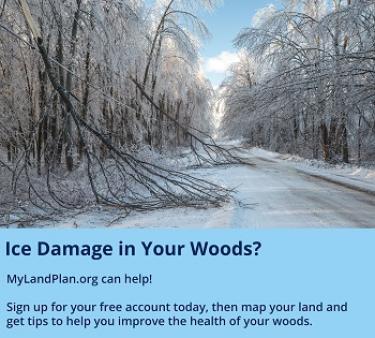The Facts About Ice Storms
Despite how widespread and damaging ice storms can be, they start out very simply: when warm and cold air meet.
To get an ice storm, you need three layers of air—a cold layer near the surface, a warm layer above that, and a cold one on top of that.
A drop of water starts out as snow in the topmost layer, then turns into rain as it falls through the warmer layer. When it enters the cold bottom layer and lands on a surface that’s less than 32° Fahrenheit, it freezes.
A large rainstorm that freezes in this way can form a thick, heavy layer of ice very quickly. That ice can make walking and driving quite dangerous, and it can spell trouble for your trees.
How Ice Storms Affect Your Forest
Ice storms put two main stresses on your woods: extreme cold and excess weight. Together, these forces can injure your trees and alter your forest.
Some of the more common effects of an ice storm include:
- Root damage. Ice storms can cause roots to break or begin lifting from the soil, which can in turn weaken your trees and cause them to topple.
- Breakage. The weight of accumulated ice can strain even strong trees. It can break a tree’s branches and even its trunk, compromising its structure and leaving it vulnerable to insect pests and disease.
- Bent trees. Smaller-diameter trees may bend under the weight of the ice. Given enough time to heal following a storm, many younger bent trees will straighten themselves out again.
- Long-term disease risk. If the ice breaks off or damages more than 75 percent of a tree’s crown, that tree is unlikely to survive. Decay fungi, insect pests and other infections can set in and destroy the tree over time.
- New growth. Due to reduced competition from surrounding trees, undamaged or only lightly damaged trees on the edge of a more heavily damaged area may actually increase their growth.
- Increased wildlife habitat. Any storm that breaks off branches or leaves larger woody debris on the ground can create new homes and nesting sites for some of the animals that live in your woods. But these piled-up tree limbs or debris can also pose a hazard to visitors or in case of wildfire.
Beyond the damage to trees, ice storms can also severely impact your property. Broken branches can topple power lines, damage buildings, block roads and clog waterways.
How well your woods weather the ice storm will depend on the age and health of your trees. But it will also depend on the steps you take after the storm to aid your forest’s recovery.
How can I get more tips?
It’s simple! Enter your email below.

